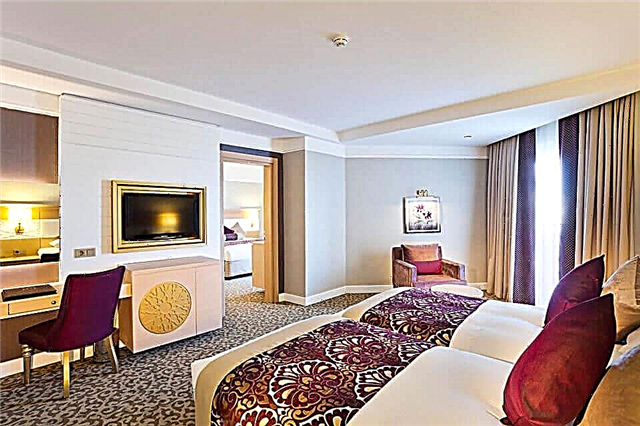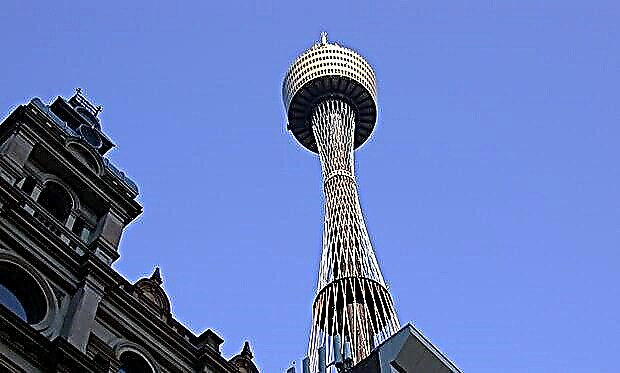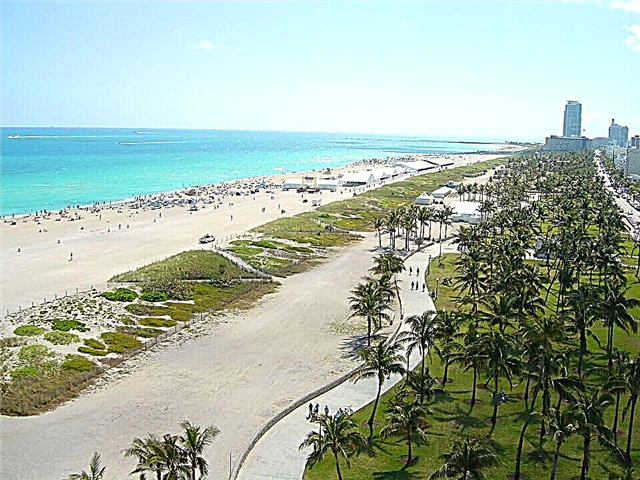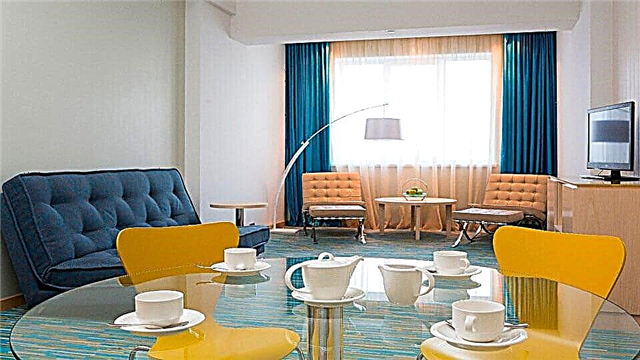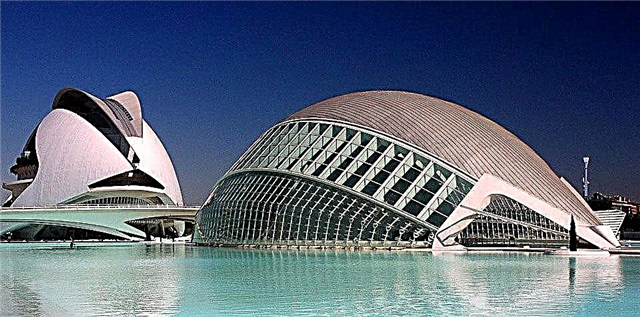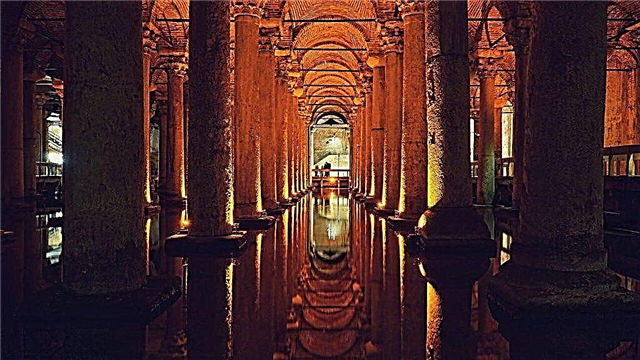Turkey is not only endless beaches, comfortable hotels, spa salons with numerous healing procedures, modern shopping centers, majestic skyscrapers. The history of the ancient country was created by bygone civilizations. Traces of their unique creations are located in every corner of the country. Ancient cities, beautiful mosques, places where the famous Alexandra Anastasia Lisowska lived, unforgettable natural attractions, I want to see everything. What to see in Istanbul in 3 days on your own will help the information of the article with a recommended list of daily visits.
First day
Over 3 thousand architectural structures, monuments created by four empires are located in Turkey. The main attraction of the country is Istanbul, which has grown on the two banks of the Bosphorus, which separates Asia and Europe. The best achievements of the two parts of the world have shaped the city's fairy tale. Its historical sites can be visited on foot or by tram number 1.
Saint Sophie Cathedral

The historical center of the city is decorated with the main attraction of the Cathedral of St. Sophia of Constantinople, the Wisdom of God, Hagia Sophia. The ancient monument of the "golden age" of Byzantine architecture for a long history (from the 6th century AD) had the status of a patriarchal Orthodox church, mosque, burial vault, museum (since 1935).
The monumental structure, surrounded by slender minarets, has an invisible aura and is considered a place of power. The cathedral was built during the reign of the Byzantine emperor Justinin I. Its walls are decorated with Arabic script and symbols of Christianity. The cathedral's sumptuous décor is available for viewing while traveling. For almost 1500 years, it has been a symbol of peace between different religions.
There were difficult moments in the history of the magnificent temple, for example, during the fall of Constantinople in 1453, Mehmet rode into the holy place on horseback and ordered to rebuild it into a mosque. The imprint of the sultan's bloody hand is preserved on the altar. Now, by order of the current President of Turkey Erdogan, the Cathedral has lost the status of a museum, and again became a mosque. For the first time in 86 years, a traditional Friday prayer was held here.
Cathedral address: Cankurtaran Mh., Soguk Cesme Sk 14-36. Take tram 1 or bus 2 to the Sultanahmet stop. Paid entrance.
Blue Mosque

Opposite the Hagia Sophia stands the majestic religious complex of Turkey. It is called Sultanahmet, Ahmedia Mosque, Blue Mosque. An example of Islamic architecture with six minarets, a royal dome is clearly visible from the expanses of the Sea of Marmara and the Bosphorus. The construction of a unique building took place at the direction of Akhmet I in the period 1609-1616.
At this time, there was a flourishing of ceramics in Iznik. The use of blue ceramics in interior decoration created an unusual atmosphere in the mosque and it became known as Blue. The inner chambers are decorated with tens of thousands of unique blue items. Until this time, six minarets only adorned the mosque in Mecca. There is no other such complex in the city. The religious cathedral is active.
During namaz, access is closed for tourists (it takes place 5 times a day). The best time to explore the premises, walk along the beautiful courtyard is morning (admission is free). Muslims and other believers can take part in prayer. The lower tier is reserved for men. Women pray separately on the second floor. It is forbidden to use cameras, other devices for taking pictures.
Address: Sultan Ahmet, Atmeydanı Cd. No: 7. You can get there by tram number 1.
Hammam Hurrem Sultan

Between the Hagia Sophia and the Blue Mosque is the city's best hammam. It was built for the beloved wife of Suleiman the Magnificent concubine Roksolana (Nastasya, Alexandra Anastasia Lisowska) in 1556. On the site of the historical baths, there were the huge baths of Zeuxippus, erected in the II, III centuries. They were destroyed long before the rule of the Ottoman Empire. The new building housed a prison, a warehouse, and a court.
Later, she became a gift for Alexandra Anastasia Lisowska, turned into a hammam and a popular city bath. The male and female halves are made in a mirror image of each other. By prior request, anyone can visit it, having familiarized themselves with the important requirements for visiting the male or female half. Tourists are offered 4 service options.
The first 45 minutes a person is washed with a hard mitten. Then the procedures are carried out. Among them are peeling, scrubbing, clay masks, the famous foam and aromatic oil massage. The longest hike is a 110 minute ritual. In the end, you are invited to try the Ottoman sherbet wrapped in a huge snow-white towel. It is issued at the entrance.
Islamic traditions prohibit nude visits to the steam room. According to ancient customs, the local population visits the baths in the morning. Tourists fill the halls of the hammam in the evening.
Address: Cankurtaran Mahallesi Ayasofya Meydani, 2. Take the metro to Sultanahmet station.
Topkapi Palace

On a high hill where the Bosphorus meets the Sea of Marmara, there is an ancient palace of the Ottoman Empire. On the cape near the Golden Horn Bay, life existed during the Neolithic. In 667, Greek colonists founded a settlement here, and a palace grew on the cape and the city began to be called Constantinople, the future Istanbul.
Here the further history of the country was formed along with 25 ruling sultans. The first stone was laid in the building of the modern palace in 1459. The name Topkapi comes from the main gate of the ancient fortress "Cannon Gates", Bab-yus-Selam or the Gate of Greetings. They have long become the hallmark of the palace. In the 8 coal towers of the gate, there were criminals awaiting the death penalty. She passed here and the instruments of torture of the executioners' rooms are available for inspection.
According to local legends, the ghosts of the executed people still roam the towers. Right behind the gates is the largest courtyard of the Divan Meydana complex. There are still underground passages from the palace, created by the Byzantines. Among the beautiful chambers, the love story of Suleiman the Magnificent and Alexandra Anastasia Lisowska developed. It has become possible to see the inner buildings of the ensemble (including the harem) since 1924, when the Topkapi Palace received the status of a museum.
The first object is the Church of St. Irene. It was erected in the 4th century on the ruins of the temple of Aphrodite, which stood in ancient times. In the oldest Christian basilica in the world, a mosaic of the apse in the form of a black cross on a gold background has been preserved. Among the thematic expositions of the museum, it is proposed to look at the world's richest collection of Islamic weapons.
Unusual porcelain products made in different countries. Examine the throne room of the palace. The museum is open from 9 to 18 hours.
Address: Fatih Historical District. It is proposed to go to it along the Divan Yolu street or come by tram number 1 to the stops of Sultanahmet, Gulhane.
Basilica Cistern

The underground buildings of the city are a separate, fabulous world of the country, keeping its history, covered with legends and myths. The Basilica cistern is considered one of these structures. The underground reservoir, created by the Greeks in the 4th century, resembles a mysterious palace hidden behind nine-meter columns (there are 336 of them).
A reserve of drinking water was kept here, it was supplied through the aqueduct to the Sultan's Grand Palace. The Basilica of Hagia Sophia used to be on this site. Therefore, the full name of the attraction sounds like Basilica Cistern (Yerebatan). The opening of the cistern is associated with the name of the Dutch traveler Gylliusa in 1550. While walking near the Church of Hagia Sophia, the traveler was surprised to notice how the locals were gathering water, fishing from mysterious underground wells.
Thus, by chance, a landmark of the country was discovered, confirming the outstanding value of ancient technologies and scientific achievements. In 1987, a museum was organized in the monument of ancient architecture of Byzantium. Walking along the wooden bridges, you can watch swimming fish, throw a coin into the "Pool of Desires", look into the eyes of the terrible stone jellyfish Gorgon.
The special acoustic qualities of the underground kingdom at a depth of 12 m allow concerts of classical and jazz music to be held here.
Address: Sultanahmet - Alemdar Mh., Yerebatan Cd., 1/3. Open from 9 am to 5.30 pm.
Theodosius cistern

The underground reservoir is 1,600 years old, but visitors were able to see it in May 2018. The reservoir was found in 2019 during the demolition of the old city hall of the Eminönü district. The UNESCO protected site was offered to visit free of charge until 2019. Now you need to buy a ticket. The underground structure is 100 years older than the Basilica Cistern.
During the construction period, the emperor of Byzantium Theodosius II was the ruler. Otherwise, the underground storage was called the Cistern of Constantine, and from the 19th century - the Cistern Sherefiye (Şerefiye Sarnıcı). The water came from the Valens aqueduct. After restoration, a new glass building was erected over the underground storage. In 2018, the Feodosia Cistern Museum began its work here.
The museum's information is filled with interesting facts about 40 reservoirs found in the city. It houses exhibitions of works by artists, concerts of classical music. On Saturdays, acoustic concerts are held here, accompanied by an unusual play of light, its reflection on the ancient walls.
Address: Piyer Loti Cd. 2/1. Take tram number 1 to the emberlitaş stop.
Bosphorus evening cruise

To finish your acquaintance with the city on the first day, it is proposed to travel along the Bosphorus. At the same time, you can have dinner at this time. In the period from 7 pm to midnight there will be interesting entertainment with traditional dances, participation in an unusual wedding. There are many options for traveling on comfortable tourist ferries.
For example, you can start your journey from the Eminenu embankment and drive along the important shipping route connecting the Marmara and Black Seas. Here is a detailed walking schedule. Reflections of majestic palaces, mosques, expensive mansions, the beauty of the city from the deck of the ship amaze with beauty and grandeur. It is better to consider them by taking a place at the port side.
Various options are offered for night and day walks along the navigable artery of antiquity. Of interest is a 6-hour trip with a stop for 2.5 hours in the village of Anadolu Kavağı.
Second day
You won't have to sleep long on the trip. We need to save time for further fascinating acquaintance with the city. That being said, it's good to know that breakfast is also a kind of attraction here. In its conduct, the customs of the country are observed. It lasts almost 2 hours and consists of numerous saucers filled with delicious products. These are: cheeses, sausages, olives, fruits, honey, etc. And hurrying to the Karaköy Güllüoğlu confectionery, you can try Turkish sweets such as kadaif, shekerpare, nuts in sugar.
Archaeological Museum

To explore the complex of three museums, you need to allocate about 3 hours of time. This is the Tiled Pavilion, museums of the Archaeological and Ancient East. The ensemble is located in the Eminonu district, near the Topkapi Palace and Gulhane Park. The exhibits are accompanied by information in English. There is no audio guide. The museum is considered the main historical attraction of the huge city.
The idea of creating the gallery belongs to the artist Osman Hamdi Bey. He was a fighter for the preservation of monuments and artistic values of Turkey. The first example of future luxury exhibitions was a 5th century tomb. The building was called the Museum of Sarcophagi. Modern exhibitions contain over a million unique exhibits belonging to different eras and cultures.
Among them are the original of the Sidonian sarcophagus, busts of Alexander the Great and Zeus, a sarcophagus with a crying woman. Parts of the ancient statues that adorned the Temple of Zeus in Pergamum, the head with a serpentine column in the Hippodrome square. There is a cafe on the territory of the complex, where you can relax and have a snack.
Address: Cankurtaran, 34122 Fatih / İstanbul. Open from 9 am to 7 pm. It is convenient to go by tram number 1 to the stops of Gulhane or Sultanahmet.
Mosaic Museum

The history of the small repository of mosaics began with excavations that uncovered the floor of the ancient building of the Grand Palace. It is believed that mosaics decorated the sidewalk of the palace, the port of the covered gallery. Later, there was a market here, destroyed and plundered in 1206. The Modern Museum is located in its place. The first visitors saw the restored masterpieces in 1953.
The exhibits of the collections are housed in two small rooms and date back to the 6th century of the reign of Justinian. The plots of the realistic mosaics are antique, not Christian. This is hunting for wild animals, scenes of harvesting, participation in battles. The scale, quality of work of mosaic panels created by ancient masters amazes with their unusualness and beauty. The pieces of the ancient floor on display in the museum are considered a wonder of the world.
Address: Sultanahmet Mahallesi Kabasakal Cad. Arasta Çarşısı Sok. 53. The museum is open from 10 am to 7 pm. The entrance is indicated by a sign in the shopping arcade of the Arasta Bazaar market or from Torun Sk street. Take tram 1 to the Sultanahmet stop.
Grand Bazaar

One of the largest indoor markets in the world is often referred to as “city within a city”. There are about 60 streets, 5000 shops, over 200 ateliers, mosques, 18 fountains with recreation areas, a cafe, a school. There is even a cemetery on the territory of the Bazaar. Conventionally, the square is divided into two historical parts: Sandalwood and Inner Besten.
The interior is made in the form of traditional columns (there are 8) and 15 domes. It sells antique furniture, antique items in the form of mirrors, coins, icons, ornaments. During the Ottoman Empire, banks, stock exchanges worked on the market square, trade and economic transactions took place. There are 18 gates leading to the Grand Bazaar. Central or Nuruosmaniye is made in the Moorish style and is considered the most beautiful.
In the old days, the gates were open from "dawn to dusk", which made it possible to call the market Kapala Charshi or the Closed Bazaar. The history of the market where slaves and valuables were traded is full of interesting facts. Now it is a real treasure house where you can buy everything: from expensive antiques to jewelry, ceramics, carpets, fabrics.
The goods are located in specialized areas (streets of Jewelry, Bracelets, Carpets, Leather, Furniture, etc.). The bazaar is open from 9 to 19 hours. Day off Sunday.
Address: Kalpakcilar Cd, Beyazit, near the Blue Mosque. The nearest ground transport stop is "Grand Bazaar - Kapaly Charshi". When choosing an entrance through a specific gate, it is better to come by taxi.
Suleymaniye Mosque

In the Old City, on one of the hills, there is the largest and most beautiful mosque in the city - Suleymaniye. It was built by order of Suleiman the Magnificent in 1557. The reign lasted 40 years and at this time the Ottoman state reached its heyday. The unique structure of the mosque became a confirmation of the greatness and importance of the empire. The building can accommodate 5,000 worshipers.
The elements of the unique building with perfect forms reflect the significant events of the ruler's reign: 4 minarets belong to the fourth Sultan of Istanbul (Suleiman). The number of balconies indicates the order in the dynasty (there are 10). The beautiful interior stained-glass windows were created by a master with the nickname "Sarkhosh", which means "intoxicated".
The territory of the mosque includes several structures for different purposes. Here, in the old cemetery, there are burials of the Sultan, Roksolana, the daughter of Mikhriman, the subsequent rulers of Akhmet, Suleiman II. Each burial has a nameplate with ancient drawings. The tombs of Alexandra Anastasia Lisowska and Suleiman were built in the form of octagonal mausoleums. Their interior decoration is allowed to be viewed through the window. The mosque is active. There are regular services.
Address: Süleymaniye Mah, Prof. Sıddık Sami Onar Cd. No: 1, 34116 Fatih / İstanbul. It works full day, but inspection by tourists takes place from 9 to 15.45. You cannot enter during prayer. The stop of the high-speed tram number 1 is called Eminonu.
Taksim Square

Each city has a square where festive events and New Year's celebrations take place. In Istanbul, this is Taksim Square (part of the territory of the Ottoman Empire) or the border between old districts and modern quarters. Here you are invited to see historical sights, relax in restaurants, cafes, choose the most convenient hotel for your stay.
Many interesting streets start in the square. In ancient times, the territory was occupied by an Armenian cemetery. It was founded by Suleiman I in the 16th century. Another tragic fact in the history of the square is the shooting of civilians during the 1977 protests. The word Taksim means distribution. From here, water entered the city's water supply system.
Nearby is the Church of the Holy Trinity. The Ataturk Cultural Center was built in the eastern part of the square. It hosts concerts, organizes temporary thematic expositions, and opera singers perform. The square is decorated with the Republican Monument, erected in 1928.
The tall building depicts the founders of modern Turkey. It is proposed to walk around the square or take a historic tram.
Address: Istanbul, Taksim Meydanı. Nearby are the terminus of many bus routes, but it is easier to go by bus # 110.
Istiklal street

The classic pedestrian trail (translated as "Independence Street") has a boomerang shape with a bend in Galatasaray Square. Its length is 1.4 km. This is a typical European area. Foreigners built houses here, opened shops and workshops. Ancient buildings in the form of Temples and mosques have been preserved on the street. At the same time, there is fun in nightclubs and restaurants nearby.
They say that this is the place where East and West converged. And in the depths under the street there is still an old metro with two stations. 100 years ago it was considered the second in the world. There are always a lot of people walking on the street. Street musicians perform here.
If there is not enough time for walking, then it is suggested to ride a retro tram. He mastered his route in 1871 and is now a kind of landmark of the city. It is recommended to start the walk after visiting Taksim Square.
Galata Mevlevi Museum

Among the many museums there is a special one: the Museum of Whirling Dervishes. It is necessary to visit it in order to learn the unique life, traditions of members of the religious order. For a long time, the building was used as a “dervish abode” or a place to live for members of a religious community. It is one of the oldest Muslim organizations, uniting followers of the Persian writer Mevlana (Jalaladdin Rumi).
The center of the order, as before, is located in the city of Konya. It observes its own laws, rules, specific ritual customs. One of them became the main property of the museum: the performance of the ritual dance of the dervishes. A special show is organized in the luxurious hall of the museum, when a fabulous whirlwind of snow-white skirts swirls in front of amazed visitors.
Each movement of the demonic dance has its own meaning. The ecstatic religious trance of the dervishes fills the room, mesmerizing those present. Among the expositions of the museum there are many exhibits demonstrating the way of life and the life of the monks of the order. A separate room is reserved for the demonstration of elements of ancient typography.
Address: Şahkulu, Galip Dede Cd. No: 15. Take the tram to the Tunnel stop.
Galata Tower

One of the famous symbols of the city is the "Tower of Christ". It appeared among the impenetrable forests of the Galata Hill in the middle of the IVX century. The Genoese built it on the site of an old building of the 5th century in honor of the seizure of the new possessions of Constantinople.
An observatory, a fire tower and a lighthouse were located among the powerful walls. Now on the 9th floor there is a popular restaurant and the best observation deck. The entire city with its mosques, bridges across the Bosphorus, streets decorated with colorful lights, floats before the gaze of amazed observers. Climbing it (from 9 to 20 hours) is offered on a modern elevator or along the ancient stone steps to hear the mysterious melody of antiquity.
Address: European part of the city Bereketzade, Galata Kulesi. Take tram number 1 to the Karakoy stop.
The third day
Despite the fact that the busy schedule of exploring the city has been completed, the last day becomes the most eventful and difficult. Hundreds of interesting places remain unvisited and occupy an important place in planning future trips to the country. To use every minute, you need to collect your luggage, take it to the airport and continue your journey.
Kadikoy district

A ferry is available for the trendy Asian side. There are no outstanding historical monuments, but among the ancient Byzantine monasteries, wooden houses of Greek families, thickets of groves with figs, an atmosphere of comfort and relaxation reigns. The sounds of cars are not heard (they are forbidden to travel around the island), and only the trampling of horses with beautiful carts is heard far away.
In small cafes you can relax, try Turkish coffee or previously unknown fruits (they are sold all year round), pet the important cats, of which there are a great many. Walk along the embankments, breathing in a special air of freedom, looking at young people in bright clothes, green hair, hurrying to educational institutions. To dream that the next visit will reveal at least a little the secrets of the ancient country: disappeared cities, underground dwellings, Mount Ararat.
Princes' islands

On the last day of the journey, you can take a ferry from the pier of Kadikoy to the Princes' Islands. There are only 9 of them, but for tourists access is allowed for 4. It is a quiet, beautiful place without the noise of cars, the hustle and bustle of people, it is beneficial to see on working days. On weekends, residents tend to come here to relax. They are attracted by the beauty, the air, the lack of tourist raids.
Small, cozy pieces of land in the Sea of Marmara are known as a place of exile for families of princes during the Byzantine Empire. Houses, churches of different religions, and other buildings erected in those distant times have survived. A visit to the largest island, Büyükada, is recommended.
How to get from the airport to the center
It is considered useful information during the trip to know the best option for the price and speed of the ride from the airport to the center. The former Ataturk Airport closed in 2019. From Moscow and other Russian cities, planes arrive at the New Airport. It is located at a distance of 30 km from the city border and 60 km from Sultanahmet Square.
For travel, it is suggested to use transport H from the IETT public network or the IST bus route from Havaist. The duration of the journey is 1 hour. You can go by taxi, and make a preliminary order when buying a ticket or at the airport.

